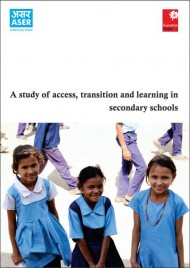
ASER Centre
Evidence for action- Home
- About Us
- ASER Survey
- Research & Assessment
- Capacity Building
- Publications & Reports
- ASER Reports
- ASER Data Over Time
- ASER 2022: Chhattisgarh
- ASER 2022 'Young Children'
- ASER 2022
- ASER 2021: West Bengal
- ASER 2021: Chhattisgarh
- ASER 2021
- ASER 2020 Wave 1
- ASER 2020 Digital Recheck
- ASER 2020: Karnataka
- ASER 2019
- ASER 2018 'Young Children'
- ASER 2018
- ASER 2017
- ASER 2016
- ASER 2015: Maharashtra
- ASER 2015 : Punjab
- ASER 2014
- ASER 2013
- ASER 2012
- ASER 2011
- ASER 2010
- ASER 2009
- ASER 2008
- ASER 2007
- ASER 2006
- ASER 2005
- Odisha Tribal Study 2022
- ASER Health Report
- Study on Access, Transition and Learning in Secondary Education
- India Early Childhood Education Impact Study
- Urban Ward Surveys
- Bihar Elementary School Study
- Inside Primary Schools
- PAHELI
- External Publications
- ASER Reports
- Data Query
- Impact
Study on access, transition and learning in secondary education: A two-block study
This two-year study (2014-2016) aimed to provide an in-depth understanding of factors that influence children’s transition from elementary to secondary school.Three interrelated issues were investigated: (i) school provisioning at the elementary and post-elementary stage; (ii) student learning outcomes at the end of elementary school (Std VIII) and one year later (Std IX), and (iii) patterns of transition into secondary schooling. The study was conducted in two rural blocks each of Hardoi district, Uttar Pradesh and Sambalpur district, Odisha (4 blocks in total) and data collection was conducted in three phases.
In the first phase, all educational and vocational centres located in selected blocks were mapped. In the second phase, a school-based survey and learning assessments of grade 8 students were conducted in all mapped schools offering this grade. In the third phase, conducted one year later, these students were tracked to record their post-elementary transition status, collect household information and administer an end-line learning assessment. Students were administered learning tests in language (Hindi and Oriya), English and math. The learning assessments included a pen and paper test followed by an oral, one-on- one test.
Findings from this study indicate inadequate provisioning of schools at the secondary stage particularly among government schools, with a consequent shift to the private sector. This trend was more evident in the surveyed blocks of Hardoi than in Sambalpur, where many more government schools provided education in the secondary grades.
With respect to transition from elementary to secondary school, the study found enormous differences across the two locations. In Hardoi, close to about 40 percent children discontinued education by end line while the corresponding proportion for Sambalpur is less than 10 percent. School continuation rates for girls in the study were much lower than those for boys as well as for the sample of children who reported to be married at end line. Multivariate analysis confirms that all factors being equal, children’s prior learning levels significantly predict their continuation into secondary grades. In other words, children with poor learning outcomes in Std VIII are likelier to drop out after elementary school.
It is equally important to note that large proportions of children in secondary grades at end line had not acquired even the most basic competencies in language and math. Of these children, about 18 percent children in Sambalpur and 26 percent children in Hardoi were unable to read a Std II level text at end line. These data indicate that children in secondary grades in these locations lack critical abilities in language and arithmetic that may not only hinder students’ ability to transact curricula of far greater difficulty than the concepts tested in this study, but also overburden secondary schools that will need to deal with the children’s learning deficits.
For more information on the study and its findings, please look at the documents below.
Duration: 2014-2016
Partners: Kusuma Trust (UK) and Pratham / ASER Centre
Location: Hardoi, Uttar Pradesh and Sambalpur, Orissa
Documents: Full Report | Policy Brief (January 2018) | Main findings

© 2025 ASER CENTRE | B 4/58 Safdarjung Enclave, New Delhi 110 029 | 91 11 4602 3612 / 2671 6084